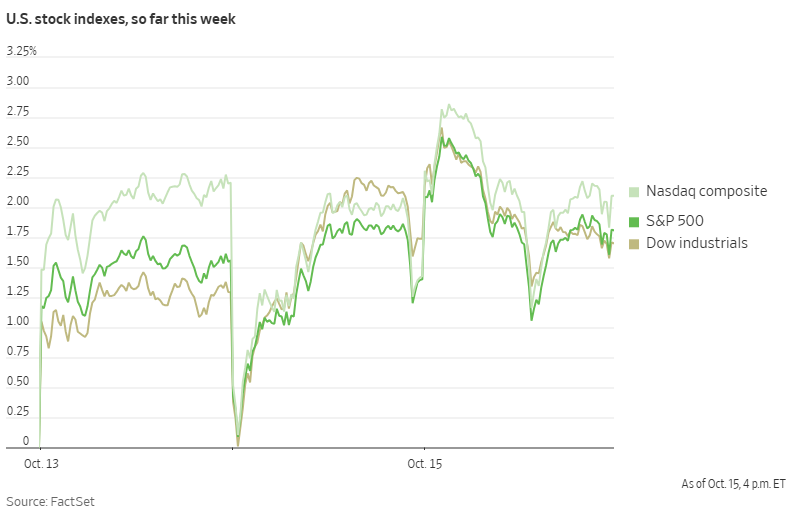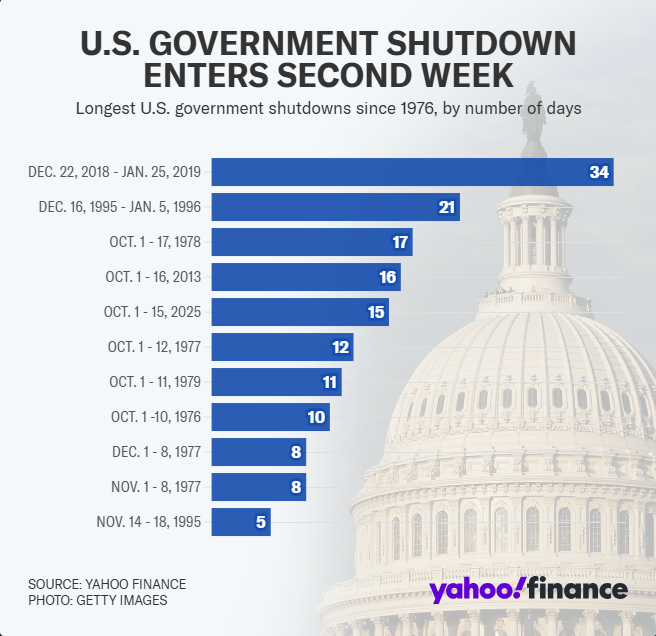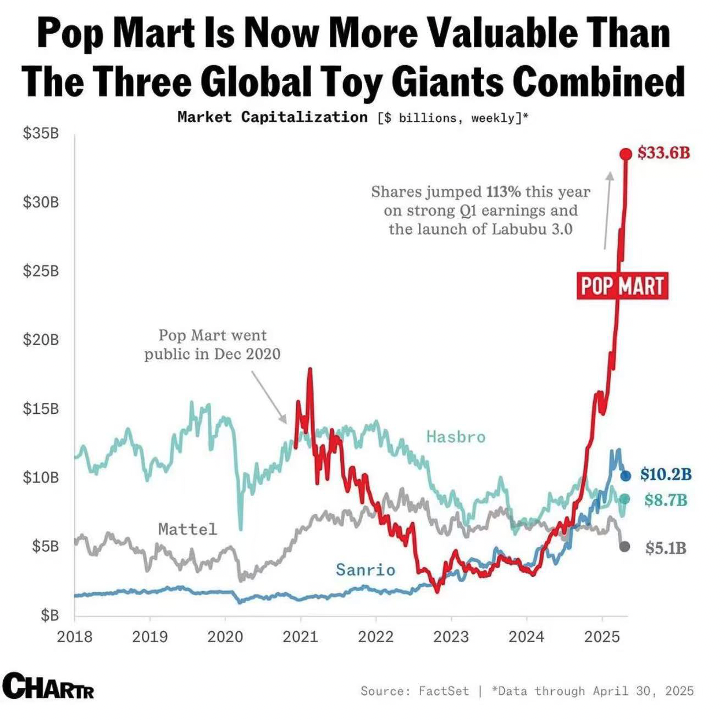市场资讯及洞察

S&P 500 and ASX Rally as Big Banks Drive Markets
Both the S&P 500 and ASX have rallied on the back of stronger-than-expected major bank earnings reports on both sides of the Pacific.
In the US, Bank of America reported a 31% year-over-year increase in earnings per share at $1.06, exceeding Wall Street's estimate of $0.95. Meanwhile, Morgan Stanley delivered a record-breaking quarter with EPS of $2.80, a nearly 49% increase from the same period last year.

On the Australian front, the benchmark ASX 200 leapt 1.03% to 8990.99, with all four major Australian banks playing a major role. CBA closed 1.45% higher, Westpac 1.98%, NAB 1.87%, and ANZ 0.53%.
These strong bank results indicate broader economic strength, despite recent concerns about US-China trade tensions. US Treasury Secretary Scott Bessent emphasised that Washington did not want to escalate trade conflict with China and noted that President Trump is ready to meet Chinese President Xi Jinping in South Korea later this month.
With the third-quarter earnings season just getting underway, these early positive results from financial institutions could prove as the start of continued market strength through to the end of the year.
U.S. Government Shutdown Likely to Last Into November
Washington remains gridlocked as the U.S. enters its 16th day of shutdown. With no signs of compromise on the horizon, it appears increasingly likely the shutdown will extend into November and could even compromise the Thanksgiving holiday season.
Treasury Secretary Scott Bessent has warned "we are starting to cut into muscle here" and estimated "the shutdown may start costing the US economy up to $15 billion a day."
The core issue driving the shutdown is healthcare policy, specifically the expiring Affordable Care Act subsidies. Democrats are demanding these subsidies be extended, while Republicans argue this issue can be addressed separately from government funding.
The Trump administration has taken steps to blunt some of the shutdown's immediate impact, including reallocating funds to pay active-duty soldiers this week and infusing $300 million into food aid programs.
However, House Speaker Mike Johnson has emphasised these are merely "temporary fixes" that likely cannot be repeated at the end of October when the next round of military paychecks is scheduled.

By the end of this week, this shutdown will become the third-longest in U.S. history. If it continues into November 4th, it will surpass the 34-day shutdown of 2018-2019 to become the longest government shutdown ever recorded.
This prolonged shutdown adds another layer of volatility to markets. While previous shutdowns have typically had limited long-term market impacts, the unprecedented length and timing of this closure, combined with its expanding economic toll, warrant closer attention as we move toward November.
Trump Announces Modi Has Agreed to Stop Buying Russian Oil
Yesterday, Trump announced that Indian Prime Minister Narendra Modi has agreed to stop purchasing Russian oil. He stated that Modi assured him India would halt Russian oil imports "within a short period of time," describing it as "a big step" in efforts to isolate Moscow economically.
The announcement comes after months of trade tensions between the US and India. In August, Trump imposed 50% tariffs on Indian exports to the US, doubling previous rates and specifically citing India's Russian oil purchases as a driving factor.

India has been one of Russia's top oil customers alongside China in recent years. Both countries have taken advantage of discounted Russian oil prices since the start of the Ukraine invasion.
Analysis suggests India saved between $2.5 billion to $12.6 billion since 2022 by purchasing discounted Russian crude compared to other sources, helping support its growing economy of 1.4 billion people.
Trump suggested that India's move would help accelerate the end of the Ukraine war, stating: "If India doesn't buy oil, it makes it much easier." He also mentioned his intention to convince China to follow suit: "Now I've got to get China to do the same thing."
The Indian embassy in Washington has not yet confirmed Modi's commitment. Markets will be closely watching for official statements from India and monitoring oil trading patterns in the coming weeks to assess the potential impact on global energy flows and prices.
Chart of the Day - Gold futures CFD (XAUUSD)


2025年5月,泡泡玛特俨然成为了港股的大明星,自2024年以来股价就已经累计上涨超过1000%。源于Labubu新品的“现象级热潮”不仅点燃了消费端,也带动公司股价连续上涨。5月21日,泡泡玛特(港股代码:9992)开盘报211港元,较年初涨幅已超45%,刷新2021年以来阶段高点。但在资本热捧与粉丝狂热交织下,我们也必须追问:Labubu的爆红,对泡泡玛特来说意味着什么?其IP资产能否形成“长期价值”?公司估值上行,是否有基本面支撑?一、股价表现:短期情绪驱动,结构性基本面回归Labubu热潮自4月初发酵后,公司股价已从140港元附近起跳。5月上线的第三代毛绒系列“前方高能”引发全球抢购潮,相关词条登顶中美热搜,泡泡玛特App甚至冲上美国App Store购物榜第一。但对二级市场而言,涨势背后更关键的是基本面验证。截至2024年报,公司实现营收62.5亿元人民币,同比增长27.3%,净利润为9.4亿元人民币,IP业务收入贡献占比超过60%。其中Labubu所在的THE MONSTERS系列销售额超过30亿元人民币,占整体近一半。

近期股价上涨固然受益于“话题性与流量红利”,但与公司在IP运营、海外扩张、产品溢价能力上的结构性增长预期并不冲突。二、IP价值重估:Labubu如何定价?Labubu的商业逻辑,其实已经跳脱出“盲盒偶发爆款”逻辑,更接近于“全球IP资产运营”。类似于迪士尼的米奇、三丽鸥的Hello Kitty,Labubu已形成了:明确的视觉识别系统粉丝社群驱动消费;跨媒体传播能力;高复购率的多品类消费模型。

据摩根大通测算,Labubu系列有望在2027年突破140亿元人民币年销售额,年复合增速高达40%。若按IP估值模型折现,其单一IP潜在价值可达400亿人民币以上,已接近泡泡玛特总市值。这意味着:Labubu不只是一次成功的产品,更是“IP资产证券化”的核心样本。三、品牌溢价与盈利模型再升级泡泡玛特在毛利率结构上具有典型“轻资产、强品牌”特征:盲盒单价从2019年的59元涨至目前的89元,毛利率稳定在64%-67%之间;Labubu毛绒款单价接近239元,而成本则是压在50元以下;App私域会员体系(泡泡玛特MEGA会员)贡献超过25%的GMV,带来显著复购与拉新能力。四、国际化与AI潮玩:新增长引擎泡泡玛特正在从“产品出海”走向“IP文化出海”。Labubu已在泰国、马来西亚、英国等国形成稳定粉丝社群;2025年计划新增8个海外门店,并在巴黎、纽约、曼谷举办Labubu巡展。作为中国的潮玩品牌,泡泡玛特2024年海外总收入达到了50.7亿,占比38.9%,欧美市场的高速增长也成为市值增长的引擎。此外,公司已于2025年Q1设立AI潮玩实验室,计划开发基于“情绪识别”“行为反应”的可交互玩偶,并与腾讯START云游戏达成合作。中长期看,公司试图构建“IP × AI × 玩具”的智能互动生态。这不仅拉高了消费频次与单价,更提升了IP生命周期与品牌护城河。五、估值空间与潜在风险截至2025年5月,泡泡玛特总市值约为1100亿港元,对应PE(TTM)为38倍,远高于国内零售平均水平,但低于全球IP运营龙头迪士尼(2025年PE约45倍)。通过数据表明公司当前估值处于“IP兑现初期+海外扩张预期”的合理溢价区间,但存在三方面风险:IP生命周期短与依赖单一IP风险(Labubu销售占比过高);线下运营安全事件(如英国门店排队混乱已引发监管关注);AI潮玩研发仍处早期,投入回报周期长。总而言之,对于泡泡玛特来说,Labubu只是起点,不是终点。泡泡玛特不是在卖玩具,而是在“做文化生意”。Labubu的成功验证了中国潮玩品牌的全球变现能力,也重构了IP与资本之间的关系。从资本角度看,这场由Labubu点燃的热潮,是“内容+用户+运营”三位一体价值链的集中爆发。未来,能否持续创造出“下一个Labubu”,才是泡泡玛特真正的长期估值锚。联系方式:墨尔本 03 8658 0603悉尼 02 9188 0418中国地区(中文) 400 120 8537中国地区(英文) +248 4 671 903作者:Yoyo Ma | GO Markets 墨尔本中文部


Introduction: Why Seeing Patterns Alone Is no more than a start pointMany traders begin their journey by being taught and then noticing visual patterns on charts such as a two-bar reversal, a classic triangle, double top or maybe a series of wicks that seem to regularly signal a turning point. These patterns often look compelling, especially when they seem to appear just before a major price move.But here's the catch, once we spot a pattern of interest we subsequently look for it, a little bit of confirmation bias may creep in so we ignore those times it may not work, and so in real terms when looking for positive technically moves at this stage arguably at best it can be described as an interesting chart story rather than a robust strategy,And yet for many, seeing some examples of where things looked exciting appears to be enough to start to trade this idea, more commonly than not, resulting in outcomes which fall short of what we hope they may be.The reality is that unless the pattern can be clearly and unambiguously defined, then tested, and of course applied and reviewed consistently, it is likely to remain in the “may have potential category. “So, encouraging you as a trader to seek out potential repeatable patterns that may be technically interesting, there is a process, a roadmap to turn this idea into something that may prove to be more than this and something that could result in a robust trading strategy,Pattern Recognition vs. Pattern ReliabilityFor humans (and I assume most of you are), pattern recognition is in-built, it is how our brains are wired, and we have an ability to find shapes, rhythms, and familiar sequences. But of course, sometimes markets are unclear, full of noise, and constantly shifting by varying degrees and for an uncertain period. So, what may appear to be a potentially reliable pattern may just be a random formation if not taken to the next level of analysis.Add to that the potential for previously mentioned confirmation bias, and the potential for recency to be viewed as important, e.g. this pattern worked last week”, this compounds the difficulties in turning this into something meaningful. So, without downplaying the merit in further exploration, if you are interested in developing a strategy around this, then we, as traders, must move beyond recognition to verification, creating clarity and measurable criteria not only for set-up but the WHOLE strategy is essential.Define It or Ditch It — The Power of Objective CriteriaIt is worth emphasising that the objective here is to have something that not only gives great results over time but MUST be created in a way that facilitates consistent trading action, only then can you be sure that it is repeatable. The first step in this is to move towards clearly defining your trading setup. You must remove any grey areas, which will appear more so in the heat of the market action. Every part of it needs to be translated into specific rules. To give the critical parts and examples, it could look something like this:
- Entry trigger (e.g., a bullish engulfing candle with increased volume)
- Confirmation filter (e.g., trend direction or volatility band breakout)
- Context filter (e.g., session time or support/resistance proximity)
- Exit condition (e.g., 2:1 reward-to-risk, opposite signal, or time-based)
- Risk management (e.g., fixed fractional, ATR stop, position sizing)
That is the start … but then you must dive deeper, striving for increased objectivity as the more you do so, you are not only enabling you to achieve consistency, but later it is easier to refine SPECIFIC parts that can make things even better.For example, instead of loosely saying, "a bullish engulfing candle," define it as thoroughly as you can with context:
- A candle whose body fully engulfs the previous one on the candle's close
- Appears after three consecutive bearish candles.
- Must close in the top third of the bar range.
- Accompanied by a volume bar higher than the two previous ones.
Now do the same for every other part of your strategy.Now you have not only a setup but more importantly, a roadmap about what to do for EVERY part of the life of the trade. Something that can be traded with absolute consistency, reviewed, and arguably more easily traded with discipline, as in the market, you have absolute clarity and what you are doing and when.Failure Detection OF course, for those interested, there are increasingly sophisticated methods to test your new system. You can turn it into an automated strategy (even if you still intend to trade it on a discretionary basis) and use formal strategy testers or code to run your system on historical data. Fortunately, manual testing is still as effective, but it is worth emphasising a few key points of good practice.The goal of this process is principled observation over sufficient time:
- Observe Across Market ConditionsWatch how your setup performs in different environments. Compare what happens (both when it works and doesn’t work so well) in ranging vs. trending markets, high vs. low volatility, before and after news events.
- Tag and Journal TradesUse a spreadsheet or journal to track setup and full system behaviour. Note the time, direction, context, and whether the trade won or lost. Include tags that can be recorded in columns such as "against trend" or "news overlap" to spot weak periods, as well as the strong ones. This will help refine any filters you are using for entry.
- Track Missed OpportunitiesArguably, it is equally important to not just journal the trades you take. Note the ones you didn’t take also (for whatever reason, e.g. you were sleeping) and treat them as important as any live trades, as they do add to the weight of evidence. (although the latter, of course, adds the extra important variable of being able to track whether you were disciplined in execution). Were you consistent in your application?
- Ask “What Broke It?”When a trade fails, identify why this may have e.g. been it in the setup itself? Is there a filter you could have considered that would avoid similar future events? Was there something in the market that may have given clues?
It is VITAL in your evaluation to remember that a losing trade isn’t necessarily a failed setup. A failed setup does not behave as expected, even when you have applied it correctly.Measuring the Edge – The Numbers are your Friend You don’t need advanced statistics to understand whether your new strategy is likely to hold water or not. These key numbers should not only be your justification for taking your strategy into the market but also the basis for ongoing evaluation to be able to assess and adjust as necessary. Basic metrics can give you a strong signal:
- Win rate: How many trades out of 10 are winners/losers?
- Average R-multiple: Are your winners larger than losers compared to the risk you are taking?
- Results Expectancy: (Win% x Avg Win) - (Loss% x Avg Loss)
- Maximum balance drawdown and trade streaks: How tough is the worst stretch, and how good is your best one, i.e. consecutive wins and losses. When we refer to drawdown, this is from the high point of your equity to its worst pullback, NOT your account start point.
You can build this evaluation process over time, record on a spreadsheet and move to 20-30 trades and beyond. Ask questions of the data you have, and you may start to notice things like:
- What times of day may be good or bad, e.g. market open
- It fails more often in range-bound markets.
- One or two big wins contribute 70% of profits.
And then there is you… So, let’s assume we have neutralised the demons of recency and confirmation bias in our system development and successfully created a system that looks as though it may create some positive trading outcomes going forward. It is then that the major mindset work begins.Even a strong strategy is weakened considerably if it’s not executed well. Many systems fail because traders lack the consistency to quite simply follow the plan.You may find yourself quitting after a small losing streak, overriding the system after a big win (or fear of missing out on something even bigger). Skipping trades due to hesitation or distraction will also impact execution.To make it clear.Without full execution, you can’t measure the success or otherwise of your system or make evidence-based judgements on what could make it even better. So, as close to 100% compliance is always the aim (and if you do stray, you will have to remove those results from an analysis you do, of course).And finally, the great news is that on the other side, having done the hard yards of follow through, and seen positive outcomes, the belief that is created in your system because you have the evidence, is much easier to continue with the discipline you need to.Final thoughts … Repeatability is the Real Edge in Your StrategiesWhat we are trying to achieve in this article is to give you a guide to moving from seeing patterns to making a profit. The only way to stack the odds in your favour and develop what many term “an edge” in your trading is by having and following a process you can trust.There are no shortcuts, but definable steps you must take, through defining your setup and whole strategy, test it, track its behaviour on an ongoing basis, and apply it with discipline, you create something potentially meaningful, and importantly, it is a fit for you as a trader.Yes, there is work, but I hope I have been able to stress the importance and potential benefits of doing the right things from start to finish.


We want to point out some interesting statistics that have us asking, Are we in a blue sky world or a cruel joke?Since the April 7th intraday lows, equities have done some astonishing things. The S&P 500 is now up 22% from that low. On April 8th, the S&P was down 15% year to date, yet it took just 25 trades from that closing low to reverse all that loss. The last time that happened was 1982 – a year the S&P went on to rally hard, and even in the preceding years before smacking into the 1987 bear crash.So are we in the blue sky?Well, currently, global equity markets are showing signs of near-term consolidation, but beneath the surface, a shift in sentiment is underway. The recent de-escalation in global trade tensions, especially from the U.S., is prompting investors to start pricing in this “Blue Sky” scenario in equities; however, it is not materialising in bonds.This is also a faint appearance of a bubble, driven by investor enthusiasm around AI and the potential for looser monetary policy later in the year. Blue Sky thinking does lead to this - markets need this goldilocks scenario and appear to think that is going to be the path rather than the exception.The realistic path is a near-term outlook that remains complex and, in some areas, fragile, in others already breaking.The Cracks While some indicators have improved, others reveal underlying softness.Take earnings revisions and/or lack of guidance altogether. The 4-week moving average for U.S. earnings revisions has seen a modest lift, but that is in no small part due to the weak U.S. dollar. The more significant 13-week moving average tells a different story.This longer-term gauge, both in the U.S. and globally, continues to lag, primarily because it trails the reporting cycle. For now, markets are clinging to hopes of an imminent turnaround in corporate earnings, but the data suggests that’s unlikely in the short run.Adding to the caution, U.S. GDP growth is forecast to slow significantly, dropping from 2% year-over-year in Q1 to less than 1% by Q4. Look at auto sales, currently booming, back the consumer feedback is that this is due to ‘tariff beating’. If that is the case, come Q3 and Q4, there is going to be a collapse in sales as the price increases come in and consumers go on strike.The FedThe Federal Reserve is now expected to stay on hold until September, according to current market pricing, and that is post-the PPI and other inflation input measures that came in lower than expected, leading equities to assume it could be earlier.Yes, the Fed is nearing the end of its tightening cycle, but a cautious tone and concerns of stagflation signal that policy normalisation will be slow, deliberate and data dependent, not sentiment driven or on geopolitics.This measured approach will be a double-edged sword; it will have opportunities for some but also elevate the risk of market volatility around key data releases, including inflation, labour market trends, and consumer spending.Tariff paths of resistance
- Path one: Moderation – consensus has a 50% blanket tariff on Chinese imports to coming into effect post-90 day pause with a 10% sector-specific measures globally – meaning the 25% tariffs on steel and aluminium will be cut to 10% and pharmaceutical which are yet to be hit will have a blanket 10%. This would lead to a moderation of the current buying in equities.
- Path two: This is the more optimistic path. If the recent tariff announcements are primarily negotiating tools rather than enduring policy shifts, markets could reprice upward. A more conciliatory tone on trade, especially ahead of the U.S. mid-term election, could reduce uncertainty and support a rerating of equities, as mentioned, this is what appears to be priced in by equities but not bonds.
- Path three: Bubble, this scenario can’t be dismissed. If investors become overly optimistic, buoyed by AI-driven gains, rate-cut speculation, and financial conditions that loosen too quickly, markets could overshoot fundamentals, reviving concerns of a speculative bubble.
The Good: UpsideSeveral forces could support further upside. Generative AI continues to be a structural driver, both in terms of productivity gains and equity multiples. Inflation is also expected to moderate. Consensus has U.S. inflation falling to 3.9% by year-end, giving the Fed cover to start easing at that September meeting. A fall in inflation, combined with improving real wage growth, could support consumer spending and corporate margins.Wage growth remains a positive offset to macro headwinds. The U.S. voluntary quit rate is still elevated, and wage gains are holding steady around 3.5%. This is helping to stabilise corporate profit margins and close the gap between labour cost growth and productivity.If this dynamic continues, particularly with inflation trending lower, it would strengthen the case for a supportive rate-cutting cycle. All market upsides.The Bad: DownsidesYet risks remain—and they are not trivial.Trade policy remains the most significant near-term overhang. With the U.S. mid-term election on the horizon, the direction of global trade remains unpredictable. Whether tariffs become a core policy plank or merely a short-term lever will shape investor sentiment through the second half of the year.Macro data surprises, particularly around inflation, labour markets, and corporate earnings, could also spark renewed volatility. At the same time, central bank missteps or unexpected geopolitical developments (of which there could be many) could easily upset the fragile equilibrium in markets.The Outlook: Is it ugly?The U.S. is expected to maintain its leadership position, but market breadth is improving. The dominance of a handful of mega-cap names is beginning to fade, and sector rotation is creating new opportunities across geographies and industries. See reactions in Europe and Asia.Meanwhile, AI continues to disrupt the investment landscape. Algorithmic trading, real-time sentiment analysis, and personalised investment models are reshaping how capital is allocated and how fast markets react. This can lead to asymmetrical trading and disparities between fundamentals, technicals and actuals.So it’s a little ugly, but that is the new world.


刚刚过去的一周,美股延续强劲走势,科技板块再次扮演核心引擎。纳指全周上涨7.15%,周五微涨继续逼近前高;标普500亦录得5.27%的周涨幅,走势几乎与纳指同步。此前市场担忧政策不确定性可能压制股指创高,但目前看来,资金情绪依然偏乐观,美股已来到一个关键的转折期。六月尾声或迎多重考验市场短期走势虽强,但中期风险并未消失。6月末将有6.5万亿美元美债到期,7月初则临近某些临时贸易政策“观察期”的节点,这两个时点都可能成为市场波动的导火索。而在上周五的上涨尾声,评级机构穆迪宣布下调美国主权信用评级,引发市场关注。这标志着继2011年标普和2023年惠誉之后,三大评级机构已全部对美国信用发出预警。这次评级调整会引发市场动荡吗?从历史来看,评级下调往往对美债及美元构成直接压力,同时利多黄金,并可能间接推高国债收益率。对股市而言,其影响则是缓慢释放的间接风险,不至于造成系统性崩盘。事实上,历史两次评级下调后,美股都在不久后重回高点,因此当前仍无需过度恐慌。市场结构:补缺风险仍在,AI仍是焦点尽管评级消息带来一定扰动,但美股本身在上周留下了显著的跳空缺口,尤其是标普指数。技术层面而言,这种级别的跳空在周线级别上很少被长时间保留,因此存在“补缺”回调的可能。板块方面,AI相关板块继续强势上攻,成为上周市场最具带动力的群体。包括AI应用、核能、量子计算、机器人等主题均出现大幅反弹,不少个股甚至已完全收复此前因政策不确定性引发的回调,部分创出新高,显示资金对科技未来的押注依然坚定。全球视角:澳洲观望降息,黄金走强今天亚太市场表现相对谨慎。澳股受制于外盘期货短线疲软,加之市场等待澳联储是否如期降息,预计整体波动有限。美元指数因评级下调小幅走弱,黄金价格则乘势反弹,避险资产阶段性受益。油价整体持稳,市场恐慌指数略有回升但仍处于可控区间。宏观焦点:演讲与展望本周财经数据相对平淡,美股暂无重要财报公布,宏观数据层面也无重大经济指标出炉。因此,市场更多会关注来自高层人物的讲话和政策态度的变化。尤其在AI板块热度高企之际,今日将有芯片巨头高层发表演讲,可能对板块情绪形成驱动。数字资产与汇市动向比特币延续强势,站稳于10.5万美元平台,市场对数字资产的热度未见退潮。汇市整体维持稳定,澳元兑美元维持在0.64附近震荡,美元兑日元仍围绕145附近波动,人民币兑美元也保持在7.2附近窄幅整理。市场感悟市场总在变化中寻找秩序,宏观风险、结构调整与板块轮动同时存在。当前或许不是市场最风平浪静的时刻,却可能是布局中长期逻辑的重要时间窗口。资金的流向、情绪的变化以及背后政策的节奏,都值得我们持续关注。联系方式:墨尔本 03 8658 0603悉尼 02 9188 0418中国地区(中文) 400 120 8537中国地区(英文) +248 4 671 903作者:Xavier Zhang | GO Markets 高级分析师


IntroductionThe commonly used approach for those who trade financial markets in developing and implementing strategies often focuses on waiting for confirmation before entering positions. While the approach may help reduce false signals and offer some psychological comfort from confirmation, it may introduce a significant drawback. When a movement has been confirmed through a defined price level, much of the potential profit may have already vanished.Consider this in light of your experience -- how frequently have you entered a trade after a clear signal, only to watch the market immediately reverse or stall? Of course, this is frustrating, but it arguably stems from a fundamental issue with such reactive trading approaches. These can place you behind the curve, rather than ahead of it.This article aims to review the standard reactive approach and explores ways that you may look to develop strategies that anticipate market movements before they materialise fully. This, at least in theory, can put you near the “front of the queue” for any potential move, so logically offering the chance of better entries and so trading outcomes through shifting your focus from confirmation to prediction.Reaction versus Prediction: What's the Difference?The Reactive approachMost trading strategies operate reactively, requiring definitive proof before committing capital to a trading idea. Consider a classic moving average crossover, a simple and commonly taught technical strategy. A trader looks at a chart until the shorter-term moving average crosses above a longer-term average, confirming an uptrend is underway. However, by definition, this signal arrives after momentum and price are already well underway.So, what is happening here is fulfilling an approach that favours certainty over timing. They value confirmation and often enter positions after key levels break or indicators flash clear signals. Of course, this approach can reduce false positives, but will typically result in:
- Later entries, often at less favourable prices
- Reduced profit potential, as a significant early movement may have already occurred
- There is more competition at obvious entry points as many traders see the same signals on the same charts, meaning markets may be moving quickly.
The Predictive AlternativePredictive strategies attempt to identify high-probability probabilities before they completely present on a chart. So, rather than requiring absolute confirmation, these approaches identify conditions that historically suggest markets are more likely to behave in a specific way next.So, let’s try and give an example. Instead of waiting for prices to breach resistance, a predictive trader notices when:
- Price range narrows significantly (possibly measured by Bollinger Band contraction or a decline in ATR)
- Volume begins increasing while price remains constrained
- Minor resistance tests become more frequent
- The lows of consecutive candles are higher than the previous ones
This set of conditions may suggest increasing buying pressure that often precedes potentially significant price movement. So, in this scenario, the predictive trader establishes a trade position before the breakout is confirmed, so anticipating rather than reacting to the event.Predictive trading is therefore based on timing over certainty, accepting some extra uncertainty in exchange for potentially superior positioning. If it proves to be successful, this approach may offer:
- Earlier entries at better prices
- Larger profit potential by capturing the full movement
- Less competition at entry points that aren't yet obvious to most traders
The similarities of both approaches and non-negotiables…Let us be clear, some of the “golden rules” MUST still be adhered to irrespective of approach in that:
- Entry is still based on strict criteria, not just a whim or guess.
- Risk must be appropriately managed both in terms of capital loss and profit risk after trade entry, including position sizing consistent with the trader’s profile
- ANY strategy must be tested on a small volume, evaluated on a critical mass of trades (not just one or two) and refined, before scaling up.
- IT is not necessarily a replacement for every strategy you may be trading, merely a different approach to add to your “trading toolbox”.
The Anatomy of a Predictive Strategy?Logically, more effective predictive strategies are going to rely on understanding market structure, the nature of price movements and some awareness of the principles of probability, rather than the alternative, which is viewing markets as random.Structural ElementsMarket structure provides the foundation for prediction. This may include:
- Support and Resistance Dynamics: Not merely horizontal lines, but zones where buyer/seller psychology might change. Predictive traders observe how the price behaves approaching these areas rather than waiting for definitive breaks.
Candle structure will always be important both singularly, e.g. where the candle closes to its range, for example, in the top or bottom half and over several candles, e.g. creating higher highs and/or higher lows (or vice versa if considering a short predictive move).
- Range Contraction and Expansion Cycles: Markets naturally alternate between periods of price consolidation and price movement, the first invariably leading to the latter. So, it makes sense that identifying late-stage consolidation patterns before they change provides at least some predictive potential.
- Volume Patterns: Changes in market participation, evidenced by changes in volume, often precede price movement. An increase in trading volume during consolidation may frequently signal an impending breakout when combined with price action that is pushing against a price point. Differences in relative volume, e.g., a higher than the norm for a specific time of day compared to other days, have been cited as an interesting variable to look at.
- Market Interrelationships: Correlations between related instruments sometimes show leading/lagging behaviours that may offer predictive value for inclusion within your criteria. For example, A move in USD may occur first before an opposite move in gold.\
- Time: Market open and sessional changes, e.g. from the Asia to European sessions, are often where a directional move is more likely to occur as more traders enter the market. Additionally, but more fluid in terms of actual time, is using time as a reference. Examples of this may be previous day or session highs or lows, whenever they occur, may be important during the evolution of the trading day.
Probability Assessment As well as market structure, predictive strategies include some sort of probability thinking. In practical terms, this means:
- An acknowledgment and underlying belief that predictions involve probabilities, not certainties, and this must be managed accordingly
- A need to identify conditions that historically are more likely to precede specific outcomes (There are ways to determine this mathematically based on previous price action that may accelerate getting to this point, but a detailed discussion of this may be worth exploring in a future article). The desirable one, of course, is that a price continues in your predicted direction, but it is equally important to be able to identify when this is less likely to happen.
- Having tested and developed unambiguous statements as part of your plan that MUST be ticked off before action.
- Continue to monitor expectancy through ongoing analysis
- Consider, particularly if you can determine a scoring system that suggests a strength of predictive signal (rather than a simpler yes/no threshold), as a way of altering lot size for any position entered.
What we are doing is getting to a place where the trader isn't guessing but simply recognising conditions that historically precede specific market behaviours. In simple terms, think of this along the lines of “If A and B and C occur, then D is likely to follow", is where we want to get to.Leading Indicators and Metrics that may Assist in PredictionSeveral technical approaches seem to be potentially beneficial for prediction. We have already considered market structure, candle action, volume and time, but the following three may also be worth some consideration.
- Volatility Measurements:
- ATR (Average True Range) compression identifies energy building in the market
- Bollinger Band width alerts traders to narrowing ranges before expansion
- Historical volatility percentiles can show where current conditions stand relative to typical behaviour
- Momentum Measures:
- The rate of change in oscillators often shifts before price action confirms
- Divergences between indicators and price suggest weakening of existing conditions and a potential change, e.g. RSI and price
- And then there is data:
- New market information is the precursor to significant potential sentiment change irrespective of previous price action. It would be amiss not to include some reference to this in any predictive plan.
Enhanced Risk ManagementBecause predictive strategies involve greater uncertainty by nature, they require a robust approach to risk management. The following are worth consideration:
- Asymmetric Risk-Reward: Predictive entries should target at least 2:1 reward-to-risk. This compensated for the lower certainty with higher payoff potential
- Tight Initial Stops: Early invalidation points, i.e. that your trading idea has not worked, make sure that losses are kept small when predictions prove incorrect
- Position sizing: Remember, there is always the option of adding to a position at any stage during a trade. Perhaps an approach that will enter a small lot size than is your norm on a reactive approach, and adding to this on confirmation, may be worth exploring.
- Partial Position Exits: Using multiple price targets to capture profits at different stages of the anticipated move. This could be combined with a move of initial stops upwards (even past breakeven)
Summary and Final ThoughtsA shift from reactive to predictive trading represents more than a technical adjustment, it requires a fundamental change in perspective. As previously stated, this does not mean, nor should it, that it is a complete shift, but rather supplementing, not replacing, what you are doing now. Indeed, there is merit in comparing approaches side by side, not only to build confidence but also as a personal “quality control” measure.Remember what you are doing here is trying to change your view of markets from something to respond to, as something to give yourself a timing edge. BUT there are no shortcuts here, you must adhere to the golden rules of market engagement as covered earlier and make sure all you do in both new plan creation and ongoing evaluation and refinement is based on some evidence and has a discipline in follow-through.Begin slowly, with one strategy, get your process sorted, and then you can move on to others with relative ease. The first will always require the most work and be the most psychologically challenging.Of course, there are automated ways that we can use through strategy creation and back testing, as well as some sophisticated probability software and machine learning techniques that can all add to your ultimate process. But these are NOT your starting point, rather things to integrate later (unless of course you are already doing some of these).Remember, the goal of any individual or set of strategies isn't perfection but rather developing a consistent positioning advantage over other market participants and so potential profit over hundreds of trades. By focusing on the next bar rather than the last, traders may have an opportunity to be in there at the start of market movements rather than follow them.It is an exciting journey ahead for those who choose to explore this further.


在量化交易与自动化投资日益普及的今天,掌握如何使用编程语言与交易平台对接,已经成为现代交易者的核心能力之一。MetaTrader 5(MT5)作为广泛使用的交易平台,不仅功能强大,还开放了Python接口,方便用户通过代码访问账户信息、持仓情况和历史交易记录。本文将带你一步步了解如何使用Python与MT5建立连接,实时查看当前持仓、获取历史订单记录,并为后续的数据分析或策略开发打下基础。无论你是刚接触程序化交易的新手,还是希望将工作流程自动化的进阶用户,都能从中找到实用的操作方法和代码示例。要使用Python操作MT5,我们需要借助 MetaTrader官方提供的MetaTrader5 Python模块。首先,像先前一样,创建链接,连接到我们的GO Markets的模拟账户。

1. 获取当前持仓信息 – positions_get()position_get()用于获取当前账户的持仓信息,使用起来非常简洁高效,仅需几行代码即可完成基本查询。默认情况下不传入任何参数,它会返回账户中所有的当前持仓。如果需要更精确的筛选,也可以根据交易品种、持仓标识或其他条件进行指定查询。

函数返回的结果是一个包含持仓信息的数组,每行对应一笔持仓,内容包括订单号(ticket)、开仓时间、交易品种、成交手数、开仓价格、当前盈亏等,信息与 MT5 平台中显示的数据保持一致。2. history_orders_get()history_orders_get()函数用于获取账户的历史交易记录。通过传入起始时间和结束时间参数,可以灵活地查询特定时间段内的所有交易订单。例如,如果我们想获取自2020年1月1日起至今的全部交易记录,只需在函数中传入对应的时间范围即可。

函数返回一个包含历史交易记录的数组,每一项对应一条具体的交易订单,内容包括交易品种、成交手数、成交价格等关键字段,便于后续的数据分析或策略回测使用。3. history_deals_totalhistory_deals_get()函数用于获取账户的成交记录,其参数格式与 history_orders_get()相同,同样需要指定查询的起始时间和结束时间。

该函数同样返回一个包含历史成交记录的数组,但与之前的 history_orders_get()不同,它返回的是与成交相关的详细信息。因此,在进行资金对账或盈亏分析时,通常以该函数的结果为准。数组中的每一项代表一笔具体成交,包含交易品种、成交手数、成交价格等关键字段。通过本文的介绍,相信你已经掌握了如何使用 Python连接MT5平台,并获取当前持仓、历史订单以及成交记录等关键信息。这些功能不仅可以帮助你实现交易数据的自动化管理,还为策略分析、回测与风险控制提供了坚实的基础。联系方式:墨尔本 03 8658 0603悉尼 02 9188 0418中国地区(中文) 400 120 8537中国地区(英文) +248 4 671 903作者:Michael Miao | GO Markets 悉尼中文部

